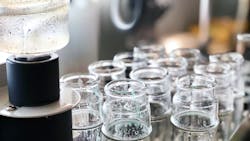There’s a new gold rush for an unmined source of data — and it’s happening right beneath our feet.
Sewage, it turns out, is full of all kinds of information worth collecting.
Businesses and utilities are finding value — including key commercial, health, and environmental indicators — in the wastewater being flushed through underground systems right now.
Just as Google and Meta collect location data and browser cookies from Internet use, wastewater engineers can track and analyze consumption habits of people and businesses through the ways they use water.
What data wastewater brings
Effluent data can even reveal more about a community than traditional Silicon Valley data. After all, lots of life goes on without electronic devices, but nothing lives without water. And every time someone touches water, they taint it with a distinct combination of chemicals, a telltale fingerprint of human use. Engineers can measure the quantity and composition of the chemicals in used water to tell what we’ve been up to with it.
As the classic toddler toilet training book says, Everyone Poops. Every flush contains a trace of what we ate, what we drank, and what medications we use.
During the COVID pandemic, public health officials around the world regularly monitored sewage systems for the spread of the virus. COVID levels typically surged in community effluent before patient levels surged in local hospital emergency rooms. Wastewater monitoring gave doctors and nurses advance notice to prepare for a rush of virus patients.
Public health officials also have used wastewater to track and contain outbreaks of other contagious illnesses, including polio, monkeypox, flu and hepatitis A.
Wastewater data also can be used to warn people away from exposure to unsafe pollution. At least 740 United States cities with 40 million residents in 30 states pollute waterways with untreated sewage during storms because of old and obsolete system designs. An EPA study found that 850 billion gallons of raw sewage was being dumped every year from more than 9,000 pipes and outflows in the U.S.
By monitoring pollution data from these discharges, public health officials can protect swimmers, surfers and anglers from unsafe conditions at beaches and rivers — and tell when it’s OK to head back into the water.
Wise US utilities are now following the lead of other environmentally sensitive countries, including Israel, South Korea, Australia and Spain, which are adopting smart sewer systems that offer real-time monitoring, modeling, data processing and AI analytics.
With climate change worsening drought, especially in the southwestern U.S., cities increasingly are stretching limited existing supplies by recycling wastewater. That makes it even more important to monitor data in wastewater. Cities like Phoenix have learned that treatment costs of converting wastewater into drinking water are reduced dramatically when they can analyze data to prevent industrial chemicals from reaching the sewer system in the first place.
Tracking chemicals through sewage
Tracking wastewater data is also paying off for law enforcement. In El Paso, regulators uncovered and tracked down a company that was improperly dumping unsafe levels of heavy metals, including mercury, copper, and aluminum, into local wastewater systems. Other researchers went through wastewater to find meth labs in Oklahoma, South Carolina, and Georgia. In San Francisco, wastewater surveillance is being used to track and combat fentanyl, cocaine, and Xylazine. Similar studies have tracked the rise and fall of other illegal drugs across Europe.
Wastewater data is not all about crime and punishment, though. By targeting and screening chemicals being discharged from factories, manufacturers can boost efficiency measures and cut their own energy and production costs. It’s also possible, for example, for pharmaceutical companies to track the effectiveness of vaccines, or telling which neighborhoods are most popular for different medicines.
It’s no secret that businesses can sample wastewater to track the competition’s industrial practices. One recent study of wastewater from 10 treatment plants along the Yangtze River delta of China found 704 chemicals being discharged, including 192 pharmaceuticals, 155 chemical products, 123 pesticides, 112 personal care products, 31 food additives and 17 hormones.
In a modern Information Age, data is among the most powerful commodities. Wastewater is one data source that is used by everyone, but valued by few. Wise businesses, regulators and public health officials are starting to realize that the data in wastewater should not be wasted — it can be used to boost public health, protect water supplies from pollution and track consumer trends.
About the Author
Ori Reshef
Ori Reshef is vice president of data of Kando, an international water engineering and data company.

